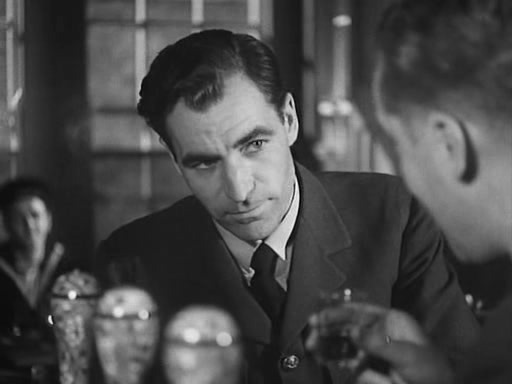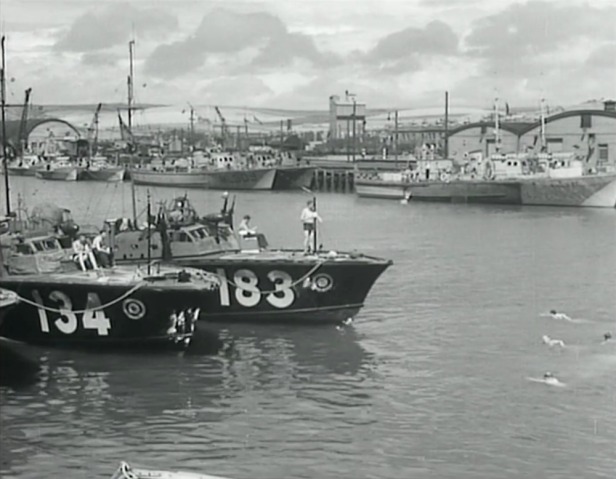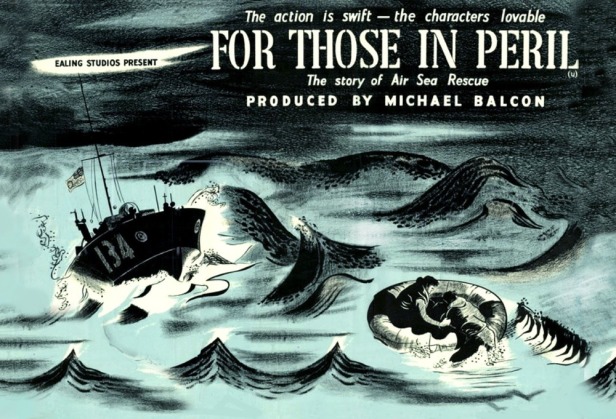For Those in Peril is perhaps the best example of the Ealing Studios wartime propaganda film. It’s a very short feature at 64 mins, just long enough to appear in a double bill as a B feature and, although featuring serving armed forces personnel, it does have two well-known professional actors in the lead roles so the film mixes documentary and feature film elements. The main purpose of the film is seemingly to introduce audiences to a little-known role for the RAF, working in collaboration with the Royal Navy. The outcome of the fictional narrative is, however, more problematic and not an obvious choice for a propaganda film.
The film’s title immediately refers to the possibility of lives lost a sea, but in this case of aircrew rather than sailors. The RAF in wartime was supplied with high speed launches (HSL) designed to find aircrew forced to ditch their planes over water. (The film’s opening sequence carefully explains why this was necessary.) The establishment of these units led to friendly rivalry with RN units who had bigger boats with more firepower but slower speeds. The film’s location seems to be Shoreham – although for obvious reasons this isn’t signified. David Farrar plays F/Lt Murray, the RAF officer in command of three launches and the fictional narrative involves the arrival of Pilot Officer Rawlings (Ralph Michael – an established actor and serving airman) who sees his posting as possibly ‘beneath’ him since he insists he should be flying. Murray is an experienced master of small boats since before the war and he tries to gently turn Rawlings’ truculence into something more positive – and gives the junior officer some harsher words when necessary. After a few exercises involving the launches joining naval craft, the film’s action sequences begin with an RAF Boston bomber being shot down over the channel. The three crew manage to launch their inflatable dinghy and their position is notified to air-sea rescue. Murray takes two launches and the larger (and slower) naval vessel follows. A Walrus seaplane is also launched. Three problems face the rescuers – thick fog, the presence of an armed German trawler and the minefield which the aircrew and their dinghy have entered.

The intriguing aspect of the narrative is its potential propaganda. The central narrative involves Rawlings and his development in a moment of crisis so that he can take command when needed with the support of his crew (who are capable and have been well led by Murray). The other propaganda message is that aircrew are not abandoned and all possible effort is expended to save them. But more problematic is the action in the film which sees an eventual ‘victory’ for British forces, but at significant cost in terms of lives lost alongside a valuable ship and aircraft. More lives are lost than saved. This is the dilemma for propaganda filmmakers in their attempt to use realism in their appeal to audiences. Men are brave and they die in the service of their country. Unfortunately, there is little direct evidence of what audiences made of a film like Those in Peril (or any details of its distribution and how many people saw it).

For me, the film works because of three factors – the documentary footage, David Farrar’s central performance and the script by Richard Hillary and Harry Watt, J.C. Orton and T. E. B. Clarke. The documentary photography is by Douglas Slocombe. This was his first credited role as cinematographer and he would go on to be one of the most celebrated figures behind the camera in British cinema history. The interiors were shot by Ernest Palmer, an experienced Ealing man. David Farrar would go on to become a leading man in three classic Powell and Pressburger films as well as two more for Ealing. For Those in Peril was perhaps his breakthrough as a leading man, but his popularity (he later claimed several hundred fan letters each week) was mainly a result of his two Sexton Blake films in 1945. Also making his first solo outing for Ealing was Charles Crichton as director. Crichton would go on to become one of Ealing’s most important directors and was probably best known for The Lavender Hill Mob (1951) and The Titchfield Thunderbolt (1953).

Richard Hillary, who wrote the original story, was a young RAF officer who first fought in the Battle of Britain aged 21. He was credited with 5 definite ‘kills’ but was then shot down and rescued by the Margate lifeboat, having suffered severe burns. During his lengthy hospital treatment he wrote one of the best books about wartime flying, The Last Enemy, which I remember reading as a child. He returned to flying but only a few months later he was killed in a nightfighter crash. His story for Those in Peril was presumably based on his own experience.
The contributions of key personnel such as Farrar, Slocombe and Crichton make this a must-see film for anyone interested in Ealing Studios. I recommend it as worth 64 minutes of anyone’s time.
I couldn’t find a trailer for the film, but this is a Pathé News report with the same title, showing the Air Sea Rescue crews at work:

